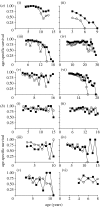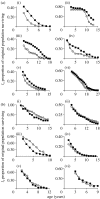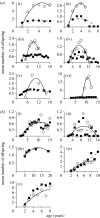Sex differences in ageing in natural populations of vertebrates
- PMID: 17939988
- PMCID: PMC2293943
- DOI: 10.1098/rspb.2007.1138
Sex differences in ageing in natural populations of vertebrates
Abstract
In many long-lived vertebrates (including humans), adult males have shorter lifespans than adult females, partly as a result of higher annual rates of mortality in males and partly owing to sex differences in the rate of ageing. A probable explanation of the evolution of sex differences in ageing is that, in polygynous species, intense intrasexual competition between males restricts the number of seasons for which individual males are able to breed successfully, weakening selection pressures favouring adult longevity in males relative to females. If this is the case, sex differences in adult longevity and in the onset and rate of senescence should be greater in polygynous species than in monogamous ones and their magnitude should be related to the duration of effective breeding males compared with females. Here, we use data from longitudinal studies of vertebrates to show that reduced longevity in adult males (relative to females) is commonly associated with a more rapid decline in male than female survival with increasing age and is largely confined to polygynous species. The magnitude of sex differences in adult longevity in different species is consistently related to the magnitude of sex differences in the duration of effective breeding, calculated across surviving adults. Our results are consistent with the suggestion that sex differences in senescence in polygynous species are a consequence of weaker selection for longevity in males than females.
Figures




Similar articles
-
Does sexual selection shape sex differences in longevity and senescence patterns across vertebrates? A review and new insights from captive ruminants.Evolution. 2015 Dec;69(12):3123-40. doi: 10.1111/evo.12801. Epub 2015 Nov 6. Evolution. 2015. PMID: 26497812 Review.
-
Sex-independent senescence in a cooperatively breeding mammal.J Anim Ecol. 2020 Apr;89(4):1080-1093. doi: 10.1111/1365-2656.13173. Epub 2020 Feb 6. J Anim Ecol. 2020. PMID: 31943191
-
Inter- and intrasexual variation in aging patterns across reproductive traits in a wild red deer population.Am Nat. 2009 Sep;174(3):342-57. doi: 10.1086/603615. Am Nat. 2009. PMID: 19653847
-
Sex-specific body mass ageing trajectories in adult Asian elephants.J Evol Biol. 2022 May;35(5):752-762. doi: 10.1111/jeb.14008. Epub 2022 Apr 26. J Evol Biol. 2022. PMID: 35470907
-
Sex differences in parasite infections: patterns and processes.Int J Parasitol. 1996 Oct;26(10):1009-23. Int J Parasitol. 1996. PMID: 8982783 Review.
Cited by
-
Epigenetic predictors of species maximum life span and other life-history traits in mammals.Sci Adv. 2024 Jun 7;10(23):eadm7273. doi: 10.1126/sciadv.adm7273. Epub 2024 Jun 7. Sci Adv. 2024. PMID: 38848365 Free PMC article.
-
A future food boom rescues the negative effects of early-life adversity on adult lifespan in a small mammal.Proc Biol Sci. 2024 Apr 30;291(2021):20232681. doi: 10.1098/rspb.2023.2681. Epub 2024 Apr 24. Proc Biol Sci. 2024. PMID: 38654643 Free PMC article.
-
Sex and early-life conditions shape telomere dynamics in an ectotherm.J Exp Biol. 2024 Feb 1;227(3):jeb246512. doi: 10.1242/jeb.246512. Epub 2024 Feb 9. J Exp Biol. 2024. PMID: 38230426 Free PMC article.
-
The role of mitochondria in sex- and age-specific gene expression in a species without sex chromosomes.bioRxiv [Preprint]. 2023 Dec 9:2023.12.08.570893. doi: 10.1101/2023.12.08.570893. bioRxiv. 2023. Update in: Proc Natl Acad Sci U S A. 2024 Jun 11;121(24):e2321267121. doi: 10.1073/pnas.2321267121. PMID: 38106076 Free PMC article. Updated. Preprint.
-
Dominance loss and tenure maintenance in Kalahari meerkats.Behav Ecol. 2023 Aug 22;34(6):979-991. doi: 10.1093/beheco/arad066. eCollection 2023 Nov-Dec. Behav Ecol. 2023. PMID: 37969548 Free PMC article.
References
-
- Beck R.M.D, Bininda-Emonds O.R.P, Cardillo M, Liu F.R, Purvis A. A higher-level mrp supertree of placental mammals. BMC Evol. Biol. 2006;6:93. doi:10.1186/1471-2148-6-93 - DOI - PMC - PubMed
-
- Berger J. The University of Chicago Press; Chicago, IL: 1986. Wild horses of the great basin.
-
- Bininda-Emonds O.R.P, Gittleman J.L, Purvis A. Building large trees by combining phylogenetic information: a complete phylogeny of the extant carnivora (mammalia) Biol. Rev. 1999;74:143–175. doi:10.1017/S0006323199005307 - DOI - PubMed
-
- Bro-Jorgensen J, Durant S.M. Mating strategies of topi bulls: getting in the centre of attention. Anim. Behav. 2003;65:585–594. doi:10.1006/anbe.2003.2077 - DOI
-
- Carranza J, Alarcos S, Sanchez-Prieto C.B, Valencia J, Mateos C. Disposable-soma senescence mediated by sexual selection in an ungulate. Nature. 2004;432:215–218. doi:10.1038/nature03004 - DOI - PubMed
Publication types
MeSH terms
LinkOut - more resources
Full Text Sources
Medical

